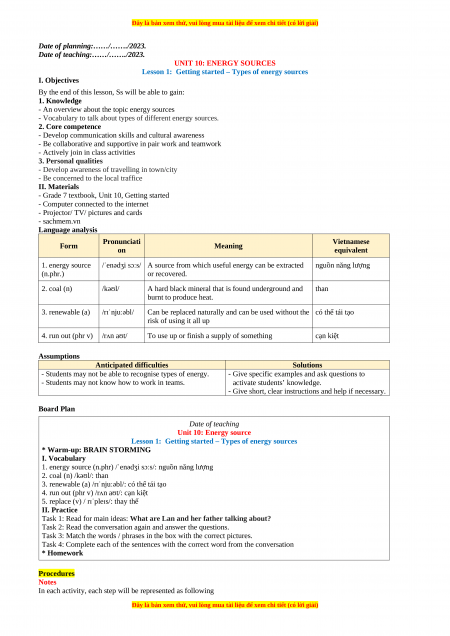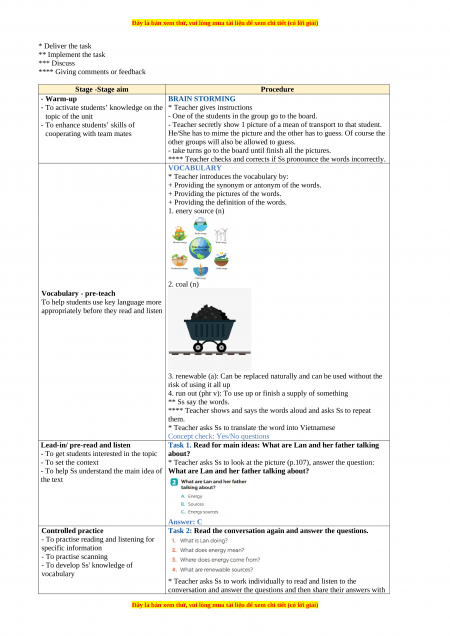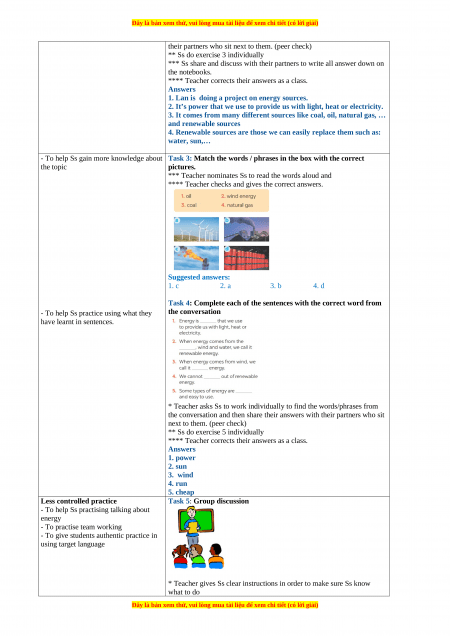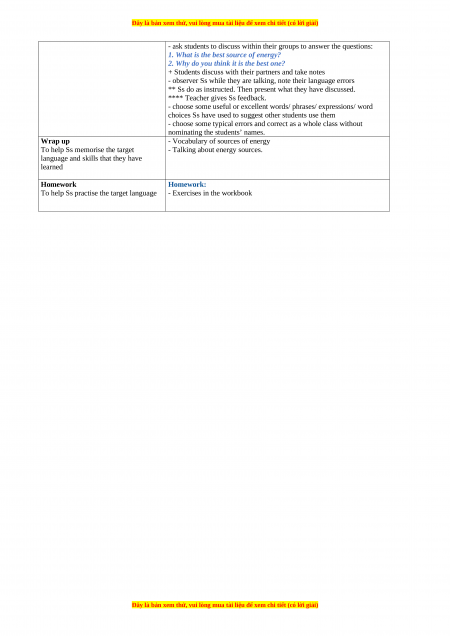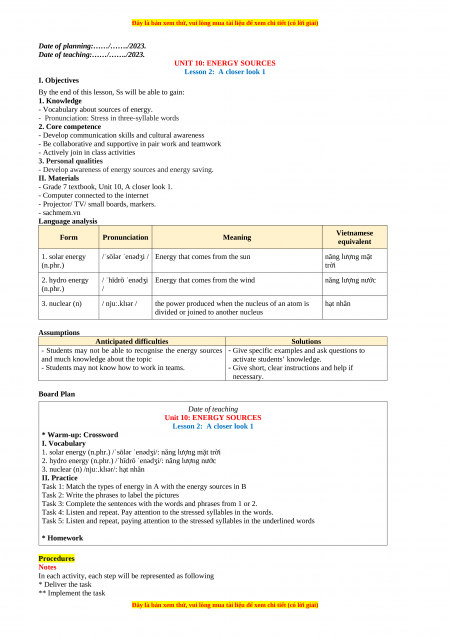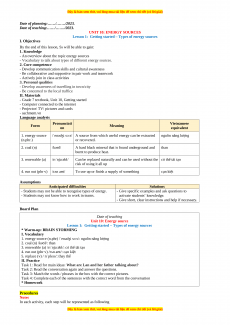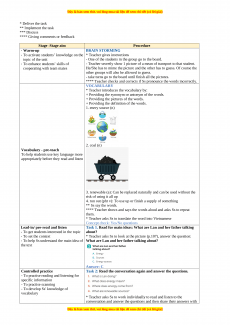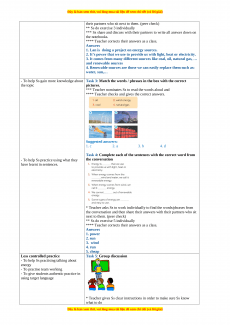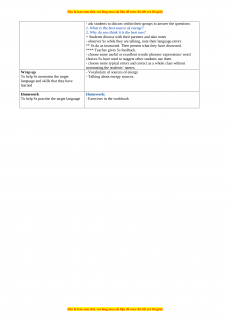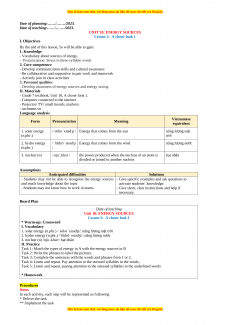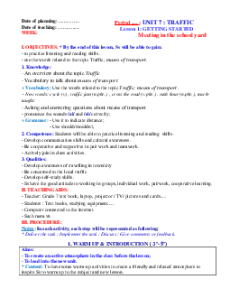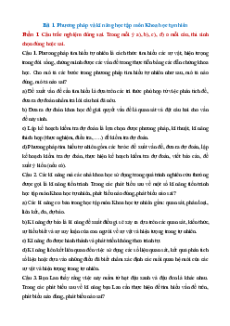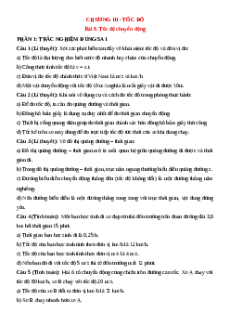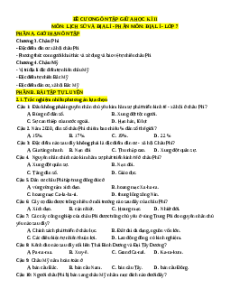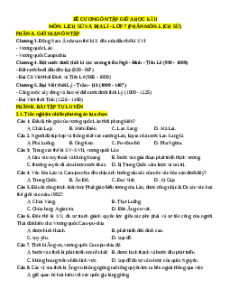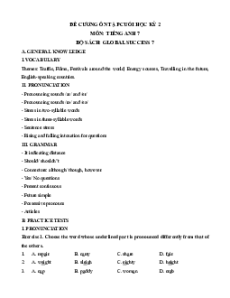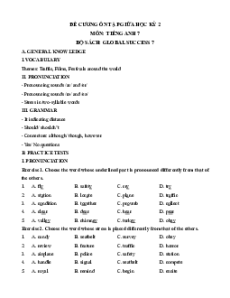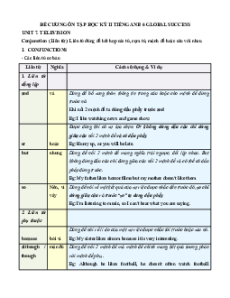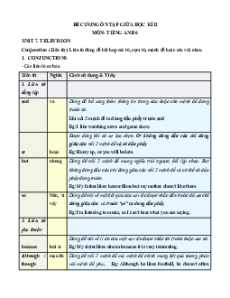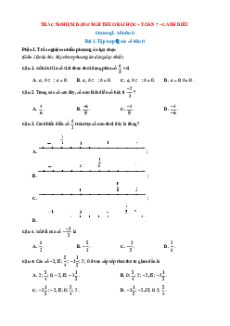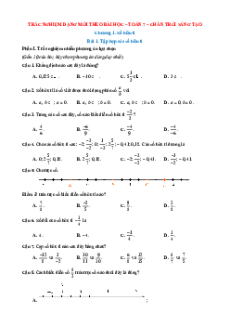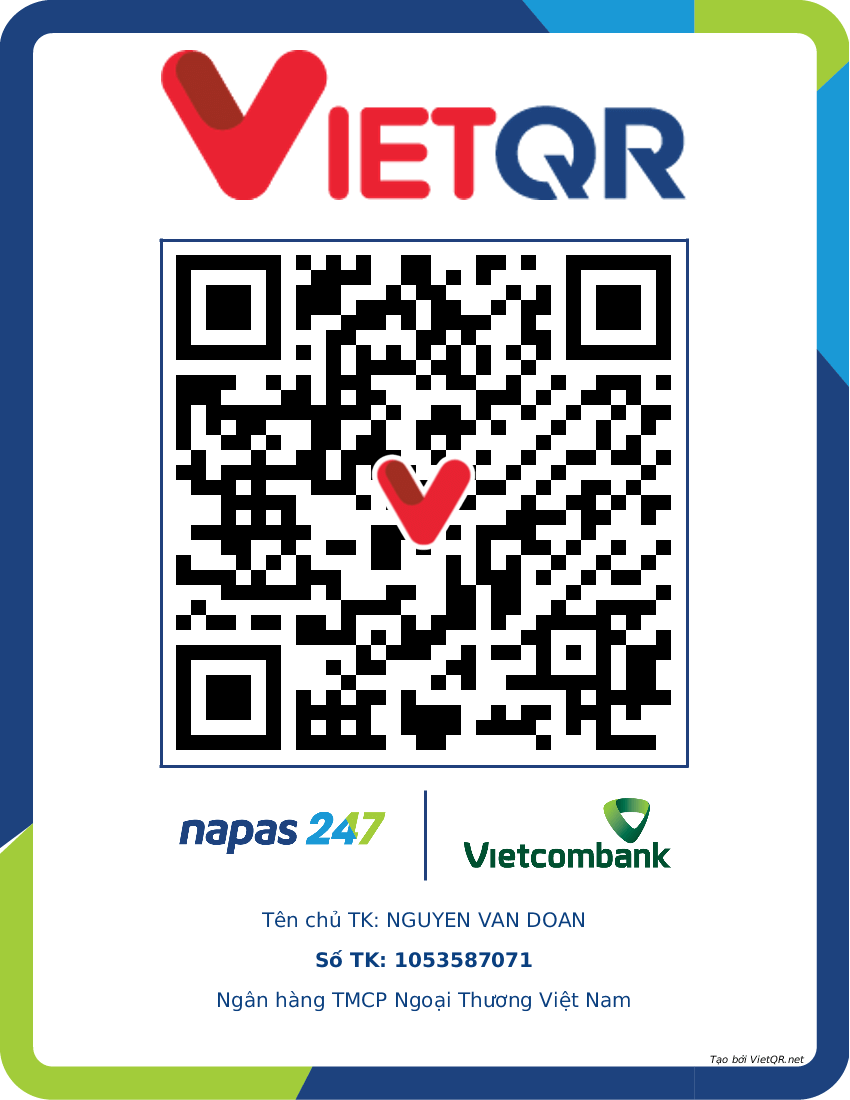Date of planning:……/……./2023.
Date of teaching:……/……./2023. UNIT 10: ENERGY SOURCES
Lesson 1: Getting started – Types of energy sources I. Objectives
By the end of this lesson, Ss will be able to gain: 1. Knowledge
- An overview about the topic energy sources
- Vocabulary to talk about types of different energy sources. 2. Core competence
- Develop communication skills and cultural awareness
- Be collaborative and supportive in pair work and teamwork
- Actively join in class activities 3. Personal qualities
- Develop awareness of travelling in town/city
- Be concerned to the local traffice II. Materials
- Grade 7 textbook, Unit 10, Getting started
- Computer connected to the internet
- Projector/ TV/ pictures and cards - sachmem.vn Language analysis Pronunciati Vietnamese Form Meaning on equivalent 1. energy source
/ˈenədʒi sɔːs/ A source from which useful energy can be extracted nguồn năng lượng (n.phr.) or recovered. 2. coal (n) /kəʊl/
A hard black mineral that is found underground and than burnt to produce heat. 3. renewable (a) /rɪˈnjuːəbl/
Can be replaced naturally and can be used without the có thể tái tạo risk of using it all up 4. run out (phr v) /rʌn aʊt/
To use up or finish a supply of something cạn kiệt Assumptions
Anticipated difficulties Solutions
- Students may not be able to recognise types of energy.
- Give specific examples and ask questions to
- Students may not know how to work in teams.
activate students’ knowledge.
- Give short, clear instructions and help if necessary. Board Plan Date of teaching Unit 10: Energy source
Lesson 1: Getting started – Types of energy sources * Warm-up: BRAIN STORMING I. Vocabulary
1. energy source (n.phr) /ˈenədʒi sɔːs/: nguồn năng lượng 2. coal (n) /kəʊl/: than
3. renewable (a) /rɪˈnjuːəbl/: có thể tái tạo
4. run out (phr v) /rʌn aʊt/: cạn kiệt
5. replace (v) / rɪˈpleɪs/: thay thế II. Practice
Task 1: Read for main ideas: What are Lan and her father talking about?
Task 2: Read the conversation again and answer the questions.
Task 3: Match the words / phrases in the box with the correct pictures.
Task 4: Complete each of the sentences with the correct word from the conversation * Homework Procedures Notes
In each activity, each step will be represented as following
* Deliver the task ** Implement the task *** Discuss
**** Giving comments or feedback Stage -Stage aim Procedure - Warm-up BRAIN STORMING
- To activate students’ knowledge on the * Teacher gives instructions topic of the unit
- One of the students in the group go to the board.
- To enhance students’ skills of
- Teacher secretly show 1 picture of a mean of transport to that student. cooperating with team mates
He/She has to mime the picture and the other has to guess. Of course the
other groups will also be allowed to guess.
- take turns go to the board until finish all the pictures.
**** Teacher checks and corrects if Ss pronounce the words incorrectly. VOCABULARY
* Teacher introduces the vocabulary by:
+ Providing the synonym or antonym of the words.
+ Providing the pictures of the words.
+ Providing the definition of the words. 1. enery source (n) 2. coal (n) Vocabulary - pre-teach
To help students use key language more
appropriately before they read and listen
3. renewable (a): Can be replaced naturally and can be used without the risk of using it all up
4. run out (phr v): To use up or finish a supply of something ** Ss say the words.
**** Teacher shows and says the words aloud and asks Ss to repeat them.
* Teacher asks Ss to translate the word into Vietnamese
Concept check: Yes/No questions
Lead-in/ pre-read and listen
Task 1. Read for main ideas: What are Lan and her father talking
- To get students interested in the topic about? - To set the context
* Teacher asks Ss to look at the picture (p.107), answer the question:
- To help Ss understand the main idea of What are Lan and her father talking about? the text Answer: C Controlled practice
Task 2: Read the conversation again and answer the questions.
- To practise reading and listening for specific information - To practise scanning - To develop Ss' knowledge of vocabulary
* Teacher asks Ss to work individually to read and listen to the
conversation and answer the questions and then share their answers with
their partners who sit next to them. (peer check)
** Ss do exercise 3 individually
*** Ss share and discuss with their partners to write all answer down on the notebooks.
**** Teacher corrects their answers as a class. Answers
1. Lan is doing a project on energy sources.
2. It’s power that we use to provide us with light, heat or electricity.
3. It comes from many different sources like coal, oil, natural gas, … and renewable sources
4. Renewable sources are those we can easily replace them such as: water, sun,…
- To help Ss gain more knowledge about Task 3: Match the words / phrases in the box with the correct the topic pictures.
*** Teacher nominates Ss to read the words aloud and
**** Teacher checks and gives the correct answers. Suggested answers:
1. c 2. a 3. b 4. d
Task 4: Complete each of the sentences with the correct word from
- To help Ss practice using what they the conversation have learnt in sentences.
* Teacher asks Ss to work individually to find the words/phrases from
the conversation and then share their answers with their partners who sit next to them. (peer check)
** Ss do exercise 5 individually
**** Teacher corrects their answers as a class. Answers 1. power 2. sun 3. wind 4. run 5. cheap
Less controlled practice
Task 5: Group discussion
- To help Ss practising talking about energy - To practise team working
- To give students authentic practice in using target language
* Teacher gives Ss clear instructions in order to make sure Ss know what to do
- ask students to discuss within their groups to answer the questions:
1. What is the best source of energy?
2. Why do you think it is the best one?
+ Students discuss with their partners and take notes
- observer Ss while they are talking, note their language errors
** Ss do as instructed. Then present what they have discussed.
**** Teacher gives Ss feedback.
- choose some useful or excellent words/ phrases/ expressions/ word
choices Ss have used to suggest other students use them
- choose some typical errors and correct as a whole class without
nominating the students’ names. Wrap up
- Vocabulary of sources of energy
To help Ss memorise the target
- Talking about energy sources.
language and skills that they have learned Homework Homework:
To help Ss practise the target language - Exercises in the workbook
Giáo án Unit 10: Energy source Tiếng Anh 7 Global success
664
332 lượt tải
MUA NGAY ĐỂ XEM TOÀN BỘ TÀI LIỆU
CÁCH MUA:
- B1: Gửi phí vào TK:
1133836868- CT TNHH DAU TU VA DV GD VIETJACK - Ngân hàng MB (QR) - B2: Nhắn tin tới Zalo VietJack Official ( nhấn vào đây ) để xác nhận thanh toán và tải tài liệu - giáo án
Liên hệ ngay Hotline hỗ trợ: 084 283 45 85
Bộ giáo án Tiếng Anh 7 Global success được cập nhật liên tục trong gói này từ nay đến hết tháng 6/2023.
Để tải tài liệu gốc về máy bạn click vào nút Tải Xuống ở trên!
Thuộc bộ (mua theo bộ để tiết kiệm hơn):
- Bộ giáo án Tiếng Anh 7 Global success năm 2023 mới, chuẩn nhất được thiết kế theo phong cách hiện đại, đẹp mắt, trình bày chi tiết cho từng bài học và bám sát chương trình Sách giáo khoa Tiếng Anh 7 Global success.
- Mua trọn bộ sẽ tiết kiệm hơn tải lẻ 50%.
Đánh giá
4.6 / 5(664 )5
4
3
2
1
Trọng Bình
Tài liệu hay
Giúp ích cho tôi rất nhiều
Duy Trần
Tài liệu chuẩn
Rất thích tài liệu bên VJ soạn (bám sát chương trình dạy)
TÀI LIỆU BỘ BÁN CHẠY MÔN Tiếng Anh
Xem thêmTÀI LIỆU BỘ BÁN CHẠY Lớp 7
Xem thêmTài liệu bộ mới nhất

Đây là bản xem thử, vui lòng mua tài liệu để xem chi tiết (có lời giải)
Date of planning:……/……./2023.
Date of teaching:……/……./2023.
UNIT 10: ENERGY SOURCES
Lesson 1: Getting started – Types of energy sources
I. Objectives
By the end of this lesson, Ss will be able to gain:
1. Knowledge
- An overview about the topic energy sources
- Vocabulary to talk about types of different energy sources.
2. Core competence
- Develop communication skills and cultural awareness
- Be collaborative and supportive in pair work and teamwork
- Actively join in class activities
3. Personal qualities
- Develop awareness of travelling in town/city
- Be concerned to the local traffice
II. Materials
- Grade 7 textbook, Unit 10, Getting started
- Computer connected to the internet
- Projector/ TV/ pictures and cards
- sachmem.vn
Language analysis
Form
Pronunciati
on
Meaning
Vietnamese
equivalent
1. energy source
(n.phr.)
/ˈenədʒi sɔːs/ A source from which useful energy can be extracted
or recovered.
nguồn năng lượng
2. coal (n) /kəʊl/ A hard black mineral that is found underground and
burnt to produce heat.
than
3. renewable (a) /rɪˈnjuːəbl/ Can be replaced naturally and can be used without the
risk of using it all up
có thể tái tạo
4. run out (phr v) /rʌn aʊt/ To use up or finish a supply of something cạn kiệt
Assumptions
Anticipated difficulties Solutions
- Students may not be able to recognise types of energy.
- Students may not know how to work in teams.
- Give specific examples and ask questions to
activate students’ knowledge.
- Give short, clear instructions and help if necessary.
Board Plan
Date of teaching
Unit 10: Energy source
Lesson 1: Getting started – Types of energy sources
* Warm-up: BRAIN STORMING
I. Vocabulary
1. energy source (n.phr) /ˈenədʒi sɔːs/: nguồn năng lượng
2. coal (n) /kəʊl/: than
3. renewable (a) /rɪˈnjuːəbl/: có thể tái tạo
4. run out (phr v) /rʌn aʊt/: cạn kiệt
5. replace (v) / rɪˈpleɪs/: thay thế
II. Practice
Task 1: Read for main ideas: What are Lan and her father talking about?
Task 2: Read the conversation again and answer the questions.
Task 3: Match the words / phrases in the box with the correct pictures.
Task 4: Complete each of the sentences with the correct word from the conversation
* Homework
Procedures
Notes
In each activity, each step will be represented as following
Đây là bản xem thử, vui lòng mua tài liệu để xem chi tiết (có lời giải)

Đây là bản xem thử, vui lòng mua tài liệu để xem chi tiết (có lời giải)
* Deliver the task
** Implement the task
*** Discuss
**** Giving comments or feedback
Stage -Stage aim Procedure
- Warm-up
- To activate students’ knowledge on the
topic of the unit
- To enhance students’ skills of
cooperating with team mates
BRAIN STORMING
* Teacher gives instructions
- One of the students in the group go to the board.
- Teacher secretly show 1 picture of a mean of transport to that student.
He/She has to mime the picture and the other has to guess. Of course the
other groups will also be allowed to guess.
- take turns go to the board until finish all the pictures.
**** Teacher checks and corrects if Ss pronounce the words incorrectly.
Vocabulary - pre-teach
To help students use key language more
appropriately before they read and listen
VOCABULARY
* Teacher introduces the vocabulary by:
+ Providing the synonym or antonym of the words.
+ Providing the pictures of the words.
+ Providing the definition of the words.
1. enery source (n)
2. coal (n)
3. renewable (a): Can be replaced naturally and can be used without the
risk of using it all up
4. run out (phr v): To use up or finish a supply of something
** Ss say the words.
**** Teacher shows and says the words aloud and asks Ss to repeat
them.
* Teacher asks Ss to translate the word into Vietnamese
Concept check: Yes/No questions
Lead-in/ pre-read and listen
- To get students interested in the topic
- To set the context
- To help Ss understand the main idea of
the text
Task 1. Read for main ideas: What are Lan and her father talking
about?
* Teacher asks Ss to look at the picture (p.107), answer the question:
What are Lan and her father talking about?
Answer: C
Controlled practice
- To practise reading and listening for
specific information
- To practise scanning
- To develop Ss' knowledge of
vocabulary
Task 2: Read the conversation again and answer the questions.
* Teacher asks Ss to work individually to read and listen to the
conversation and answer the questions and then share their answers with
Đây là bản xem thử, vui lòng mua tài liệu để xem chi tiết (có lời giải)

Đây là bản xem thử, vui lòng mua tài liệu để xem chi tiết (có lời giải)
their partners who sit next to them. (peer check)
** Ss do exercise 3 individually
*** Ss share and discuss with their partners to write all answer down on
the notebooks.
**** Teacher corrects their answers as a class.
Answers
1. Lan is doing a project on energy sources.
2. It’s power that we use to provide us with light, heat or electricity.
3. It comes from many different sources like coal, oil, natural gas, …
and renewable sources
4. Renewable sources are those we can easily replace them such as:
water, sun,…
- To help Ss gain more knowledge about
the topic
- To help Ss practice using what they
have learnt in sentences.
Task 3: Match the words / phrases in the box with the correct
pictures.
*** Teacher nominates Ss to read the words aloud and
**** Teacher checks and gives the correct answers.
Suggested answers:
1. c 2. a 3. b 4. d
Task 4: Complete each of the sentences with the correct word from
the conversation
* Teacher asks Ss to work individually to find the words/phrases from
the conversation and then share their answers with their partners who sit
next to them. (peer check)
** Ss do exercise 5 individually
**** Teacher corrects their answers as a class.
Answers
1. power
2. sun
3. wind
4. run
5. cheap
Less controlled practice
- To help Ss practising talking about
energy
- To practise team working
- To give students authentic practice in
using target language
Task 5: Group discussion
* Teacher gives Ss clear instructions in order to make sure Ss know
what to do
Đây là bản xem thử, vui lòng mua tài liệu để xem chi tiết (có lời giải)

Đây là bản xem thử, vui lòng mua tài liệu để xem chi tiết (có lời giải)
- ask students to discuss within their groups to answer the questions:
1. What is the best source of energy?
2. Why do you think it is the best one?
+ Students discuss with their partners and take notes
- observer Ss while they are talking, note their language errors
** Ss do as instructed. Then present what they have discussed.
**** Teacher gives Ss feedback.
- choose some useful or excellent words/ phrases/ expressions/ word
choices Ss have used to suggest other students use them
- choose some typical errors and correct as a whole class without
nominating the students’ names.
Wrap up
To help Ss memorise the target
language and skills that they have
learned
- Vocabulary of sources of energy
- Talking about energy sources.
Homework
To help Ss practise the target language
Homework:
- Exercises in the workbook
Đây là bản xem thử, vui lòng mua tài liệu để xem chi tiết (có lời giải)

Đây là bản xem thử, vui lòng mua tài liệu để xem chi tiết (có lời giải)
Date of planning:……/……./2023.
Date of teaching:……/……./2023.
UNIT 10: ENERGY SOURCES
Lesson 2: A closer look 1
I. Objectives
By the end of this lesson, Ss will be able to gain:
1. Knowledge
- Vocabulary about sources of energy.
- Pronunciation: Stress in three-syllable words
2. Core competence
- Develop communication skills and cultural awareness
- Be collaborative and supportive in pair work and teamwork
- Actively join in class activities
3. Personal qualities
- Develop awareness of energy sources and energy saving.
II. Materials
- Grade 7 textbook, Unit 10, A closer look 1.
- Computer connected to the internet
- Projector/ TV/ small boards, markers.
- sachmem.vn
Language analysis
Form Pronunciation Meaning
Vietnamese
equivalent
1. solar energy
(n.phr.)
/ˈsōlər ˈenədʒi / Energy that comes from the sun năng lượng mặt
trời
2. hydro energy
(n.phr.)
/ ˈhīdrō ˈenədʒi
/
Energy that comes from the wind năng lượng nước
3. nuclear (n) / njuː.klɪər / the power produced when the nucleus of an atom is
divided or joined to another nucleus
hạt nhân
Assumptions
Anticipated difficulties Solutions
- Students may not be able to recognise the energy sources
and much knowledge about the topic
- Students may not know how to work in teams.
- Give specific examples and ask questions to
activate students’ knowledge.
- Give short, clear instructions and help if
necessary.
Board Plan
Date of teaching
Unit 10: ENERGY SOURCES
Lesson 2: A closer look 1
* Warm-up: Crossword
I. Vocabulary
1. solar energy (n.phr.) /ˈsōlər ˈenədʒi/: năng lượng mặt trời
2. hydro energy (n.phr.) /ˈhīdrō ˈenədʒi/: năng lượng nước
3. nuclear (n) /njuː.klɪər/: hạt nhân
II. Practice
Task 1: Match the types of energy in A with the energy sources in B
Task 2: Write the phrases to label the pictures
Task 3: Complete the sentences with the words and phrases from 1 or 2.
Task 4: Listen and repeat. Pay attention to the stressed syllables in the words.
Task 5: Listen and repeat, paying attention to the stressed syllables in the underlined words
* Homework
Procedures
Notes
In each activity, each step will be represented as following
* Deliver the task
** Implement the task
Đây là bản xem thử, vui lòng mua tài liệu để xem chi tiết (có lời giải)
